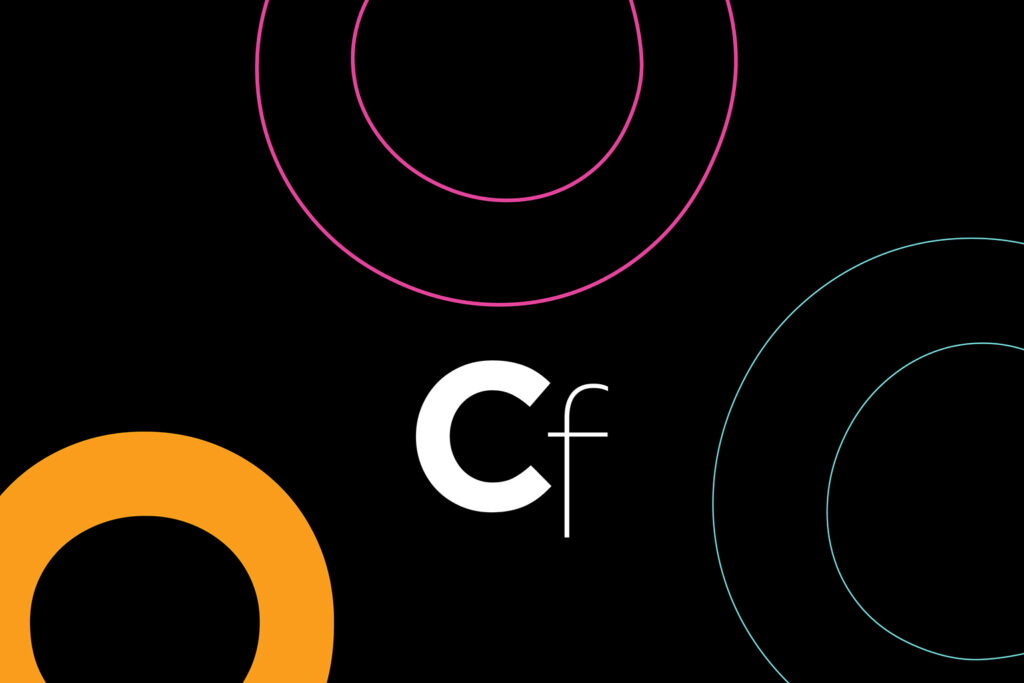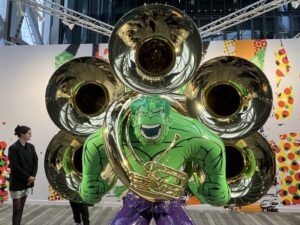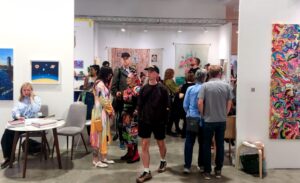New York Fairs Return to One Jam-Packed Week, Amid Major Market Shifts

Editor’s Note: This story originally appeared in On Balance, the ARTnews newsletter about the art market and beyond. Sign up here to receive it every Wednesday.
May is a ritual in the New York art world. Fairs rise in every corner of the city—from Hudson Yards to Gowanus to the Estonian House on East 34th Street—while galleries scramble to mount ambitious shows and collectors double-book dinners between Tribeca and the Upper East Side. The auction houses follow close behind with their schedule of marquee evening sales. By Memorial Day, the art world has rendered its verdict on the current market, with only Art Basel standing in the way of summer breaks in the Hamptons or Mallorca.
While in years past, the New York fairs have been spread out across early and mid-May, this year everything is packed into one overstuffed week that kicks off Wednesday with the VIP preview of Frieze. And, with the market in the throes of a full recalibration after two years of softening sales and the Trump tariffs casting doubt on hopes of recovery, the stakes are higher than ever.
Last month, after Art Basel and UBS dropped their annual Global Art Market report, I dubbed the current moment the “Great Bifurcation.” While the report found that global sales fell 12 percent last year to $57.5 billion, the second year in a row that recorded a substantive contraction, it also found that transaction volume had risen by three percent, suggesting not collapse, but fragmentation. The top end of the market has slowed—sales above $10 million dropped 39 percent and now account for just 18 percent of the market’s value. Meanwhile, works under $50,000 have gained market share.
“There’s no doubt we are in a difficult moment,” art advisor Candace Worth told ARTnews earlier this week. “There’s so much unpredictability. The general sentiment among the art-buying public seems to be that they don’t want to spend above a certain price point until they feel a little more confident about what’s going on, globally, financially, politically.”
Worth noted that the market environment is influenced also by what came before it—as in, the boom in buying that accompanied the years just before and after the pandemic. The unstable economy is a factor, but there is also a buying “hangover.”
“People bought so much art at such a steady clip over the last five to seven years,” she said “Now they are looking at, in some cases, dropping values, rising storage costs. And they start to ask themselves, ‘What am I doing with all this? Do my kids want this art? Am I donating it?’”
But, as the Art Basel UBS report found, collectors are buying, just at a lower price point. That sentiment was echoed by multiple dealers who said they’d experienced this dynamic first-hand, seeing buyers remain cautious at higher price points and more active at lower ones. Will that mean a flood of lower-priced works across this week’s fairs?
Last year at Independent, one of the more established satellite fairs, most sales happened in the $10,000 to $20,000 range, even though only around 200 works at the fair were in that range, according to founder Elizabeth Dee. This year, she expects the inventory—and sales— of such works to jump considerably.
“Now, this year, we have the majority in the $10,000 to $20,000 range,” Dee said.
Lower East Side gallery Magenta Plains, which is showing at Independent for the eighth year, is displaying works by Roberto Juarez priced between $12,000 and $18,000.
“Our approach has often been to bring artists who deserve more exposure but whose price points aren’t already very high. It’s a sweet spot for us and for Independent,” co-founder and director Olivia Smith told ARTnews. “We’ve always been conservative with our price increases, and I’ve never regretted it. We want collectors to think, ‘Why don’t I already own this?’”
Even amidst a wave of gallery closures in recent years, smaller galleries seem to have momentum. According to the Art Basel UBS report, galleries with under $250,000 in turnover saw a 17 percent sales bump last year. Blue-chip dealers, by contrast, posted a 9 percent decline. The sticker shock is real: Artsy’s annual dealer and collector survey found that 78 percent of collectors walked away over pricing last year, and just 15 percent of galleries see transparency as a useful tool.
Still, from Los Angeles to Dubai, market insiders remain bullish. Now is the time to buy, some say. Now is the time to open a gallery. Strike while the world is distracted, and you may not have to fight for attention.
“We are in the middle of a generational pivot,” Dee said. “Some collectors say they need to assess the market before making their next move. But new collectors are emerging who don’t have comparables—they’re not risk-averse because they’re just beginning to develop their eye and collection. This is simply the environment they’re starting in.”
One might recall another big trend bandied about in art and finance circles: the “Great Wealth Transfer.” Sotheby’s CEO Charley Stewart recently said he expects this “tsunami” of wealth and assets passing from Baby Boomers to their children to unlock lots of new material for the auction houses. Squint and you can see those same children—born into art collecting families—buying up works to develop their own taste and collection.
Some galleries, like Nara Roesler—based in New York and Sao Paolo—are sufficiently optimistic to participate in two fairs this week.
“We opened [Marco A. Castillo’s “from the circle to the star”] last week and the conversations with clients have been very good,” Daniel Roesler told ARTnews. “But then again, being Brazilian, I’m used to this kind of market turbulence,” he added with a laugh. “The market operates in a mysterious and magical way. It will keep going.”
Nara Roesler is one of a handful of galleries doing both Frieze and TEFAF. At TEFAF, where the gallery is showing works by Maria Martins and Piet Mondrian, prices are around $1 million. At Frieze, artists include Carlos Bunga, Carlito Carvalhosa, and Sheila Hicks, with works priced between $50,000 and $100,000.
Ortuzar Projects is following a similar playbook. At TEFAF, they’re partnering with Marc Selwyn Fine Art on a joint presentation of works by Lee Bontecou, including a late-period sculpture priced over $9 million. Meanwhile, at Frieze, they’ll show still lifes by Joey Terrill priced between $50,000 and $75,000.
Thaddaeus Ropac, the Austrian dealer, is also optimistic—cautiously.
“There was less activity after the preview was sent out compared to the last few years, which tells you something,” Ropac told ARTnews. “But that’s not a bad thing. It reminds me of when we had more time to spend with collectors and curators. Discussions are slower, but I think that helps the work to be understood.”
At Frieze, Ropac is showing works ranging from an Oliver Beer painting at $43,500 to an Alex Katz portrait at $600,000 and a $1.475 million Georg Baselitz work. At TEFAF, he’s showing Daniel Richter paintings around $475,000.
This isn’t just a week of sales and schmoozing. It’s a referendum on what the art world considers worth seeing, worth spending money on, and worth staging in a city that still insists on being the center of it all. What happens here doesn’t just echo across Chelsea. It gets noted in Basel next month, not to mention Seoul, Lagos, Paris, and Dubai.
Expect no shortage of spectacle. If dealers and auction houses have learned anything from the past two years, it’s that well-priced, high-quality work will likely find buyers. New York is still the art world’s de-facto capital, and the US commands more than double the market share of any other region. Buzz sells—and buzz starts with people in booths.
With so many fairs happening this week, click here for a breakdown of the most important on view, and what to look for at each.







